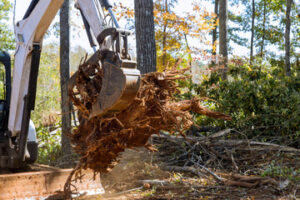Land Clearing Buda TX involves removing trees and other plants from an area of land to make it more accessible. It is often used for agricultural or construction purposes, and can help prevent fire hazards by removing dead vegetation.

It also helps boost property value by making it more attractive to potential buyers or investors. However, choosing the right method is essential for achieving optimal results.
A land clearing project requires specialized tools for safety, efficiency, and precision. These essential hand tools include axes, shovels, spades, and specialty blades. By ensuring these tools are in good working condition and prioritizing safety measures, land clearing projects can be conducted safely. This will ensure the job is done correctly and avoid costly mistakes that can compromise the success of a project.
Modern land clearing techniques prioritize sustainable practices and ecological considerations to reduce environmental impact. They also enable fast completion of a project and improve the effectiveness of construction and forestry operations. However, some of these methods can be inefficient if used for larger-scale projects or for dense vegetation. Careful evaluation of the site conditions and available resources will help determine the optimal clearing technique for each situation.
Regardless of the purpose of a land clearing project, the most important thing is to clear the land properly. This will allow vehicles and equipment to easily move around the property, reducing the risk of accidents or injuries caused by tripping hazards. Clearing can also prevent wildfires by removing dead or flammable plants from the property.
Land clearing is an integral part of any construction or development project, and can be a great way to prepare the site for building foundations and roads. It can also help identify any potential obstacles or challenges that may need to be addressed before construction can begin, saving time and money for the entire project.
Another benefit of land clearing is the ability to improve soil health. By removing excess vegetation, the nutrients in the soil are redistributed evenly, which will promote healthy growth for surrounding plants. It can also eliminate pest infestations by eliminating habitats for rodents and insects.
Some landowners choose to use their cleared property for additional purposes, including farming and raising livestock. This can provide a source of income and contribute to the local economy, as well as provide a healthier environment for animals and humans. Moreover, clearing the land can help prevent erosion and other natural disasters by preventing the buildup of debris and sediment.
Machinery Clearing
Whether you need to prepare land for construction, agriculture, or enhance the property’s overall appearance, the right land clearing techniques will help achieve your goals. While traditional methods require manual labor, modern approaches utilize advanced machinery to provide faster results and minimize environmental damage. Considering the unique demands of each situation, carefully evaluating the advantages and challenges of grubbing vs dozing will help determine which clearing technique is best for your needs.
A wide range of equipment is used to perform land clearing jobs, from simple hand tools such as axes and hatchets to large-scale machines like bulldozers and excavators. For smaller projects, chainsaws are an efficient tool for cutting and removing branches and small trees. Stump grinders, on the other hand, grind down tree stumps and roots to make them easier to remove with hand tools or by machine. When larger debris such as rocks or logs are in the way, a track excavator can dig them out of the way quickly and efficiently.
In addition to using heavy equipment, skilled contractors must know how to operate it safely and efficiently. Land clearing isn’t just about moving dirt and trees — it requires a high level of critical thinking to deal with unexpected obstacles and make the most of the available space. It’s also important to be able to identify and repair broken machinery promptly so that the work can continue as planned.
Both grubbing and dozing are fast land clearing methods that result in smooth, even terrain. However, grubbing is time-consuming and may leave large holes in the ground. This can present challenges if you plan to use the land for pasturing or haying, as these holes will interfere with the soil’s integrity.
Both grubbing and dozing can be used to clear wetlands, forests, and riparian areas, but they require special consideration for the environment and must follow local regulations. For example, in many states, a permit is required to clear wetlands and forests because these areas are protected by law. Additionally, grubbing and dozing can cause erosion and water contamination, which means you must take extra steps to mitigate these impacts.
Chemical Clearing
Land clearing is the process of removing trees, brush and other vegetation from a piece of land. This can be done for various reasons, including preparing the site for construction; clearing vegetation that interferes with power lines or pipelines; and removing trees to improve property value. The process can be difficult, especially if there are large trees to be removed and heavy equipment is needed. Land clearing can also be done for conservation purposes, such as preserving wetlands or protecting wildlife habitats.
There are many different types of land clearing techniques, and each one has its own advantages and disadvantages. The type of clearing technique that is best for you will depend on the size of your project, environmental considerations, and maintenance concerns. In general, modern land clearing methods offer greater efficiency and lower environmental impact than traditional methods. They often utilize machinery that is more effective at tackling larger projects, and they also incorporate measures like selective clearing, which reduces the impact on delicate ecosystems.
While land clearing is a necessary part of urban development, it can have negative effects on the environment. It can lead to soil erosion, water pollution, and habitat destruction, and it can also release harmful greenhouse gases. For this reason, it’s important to choose a land clearing method that is environmentally friendly.
If you’re looking for a sustainable, environmentally friendly way to clear your land, mulching may be the solution. This method involves grinding up vegetation and turning it into mulch, which can then be used for a variety of purposes. This includes erosion control, soil improvement, and as a source of fuel.
In addition to being eco-friendly, mulching is a cost-effective and efficient method of land clearing. It can be used to create roads and driveways, and it can even help reduce the cost of building infrastructure. It’s important to note that there are some regulations associated with land clearing, so it’s best to hire a professional company that follows these rules.
Land clearing is a necessary part of preparing a piece of land for construction, but it can be a complicated process. Choosing the right land clearing method will ensure that your project is completed on time and without any environmental impact.
Environmental Clearing
Land clearing is a complex and vital process that prepares raw, undeveloped land for construction and agricultural use. It can also enhance a property’s beauty and value, making it more attractive to prospective buyers or tenants. Land clearing can also be required by local zoning laws and regulations.
The land clearing process involves the removal of trees, vegetation, and other debris from a property. It can be done using hand tools, mechanical equipment, or chemical herbicides. The best method for a particular site depends on a variety of factors, including the type of vegetation being cleared, the size of the area, and the terrain.
Many modern land clearing techniques prioritize sustainability and ecological considerations. For example, selective clearing, which removes specific types of vegetation while preserving others, helps to maintain biodiversity and protect fragile ecosystems. In addition, minimizing soil erosion and sedimentation in nearby waterways is an important goal of land clearing.
Another advantage of land clearing is the ability to restore wildlife habitats. By removing invasive species and promoting the growth of native plants, land clearing can create open grasslands and wetlands that provide food and shelter for a variety of animals. In addition, clearing land can reduce the spread of fire-prone conditions by creating a natural firebreak and eliminating flammable material like weeds and dead tree stumps.
Clearing land for development can be a critical first step in urban development. It is what turns a raw plot of land into a commercial building site or new residential neighborhood. However, it can be challenging to achieve the desired results without compromising environmental integrity. That’s why it’s important to choose the right clearing method for each job.
Once land has been cleared, it’s crucial to follow up with proper maintenance. Regular pruning, weeding, and mulching can help prevent invasive species from taking over and preventing the growth of other desired vegetation. Also, timely and consistent fire suppression can help protect the newly cleared land from future threats.
